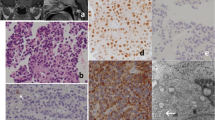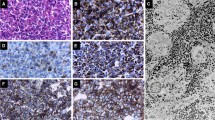Summary
Within our surgical collection clinically inactive pituitary adenomas represent 30.7% of all pituitary tumours. To characterize their endocrine activity we studied 40 clinically inactive pituitary adenomas with in situ hybridization (ISH) using cRNA probes labelled with35S encoding growth hormone (GH), prolactin (PRL) and chorionic gonadotrophin (βHCG). No tumour was associated with clinical evidence of elevated hormone secretion. A mild hyperprolactinaemia not correlated with hormone or the mRNA content of the cells was interpreted to be incidental in 11 patients. By histological analysis, immunohistochemistry (IH) and electron microscopy the adenomas were diagnosed as small cell chromophobic (n=16) and large cell chromophobic (n=8) adenomas, and oncocytomas (n=16). Gene expression of one or more hormones was identified by ISH in 18 of 40 adenomas in few cells. GH and PRL gene expression was rare (GH mRNA in 3 of 40 tumours and PRL mRNA in 8 of 40 tumours) whereas in 14 of 40 adenomasβHCG/βLH gene expression was identified in scattered cells. Five of 40 adenomas lacking hybridization signals revealed hormones by IH. The detection of mRNA was accompanied by positive immunostaining for the respective hormones in 72%. The combination of ISH and IH reveals good evidence that the hormones are synthesized in the tumours and not taken up from the serum and stored in the cells. The two methods used together permit a more precise analysis of tumour biology than each alone.
Similar content being viewed by others
References
Asa SL, Gerrie BM, Singer W, Horvath E, Kovacs K, Smyth HS (1986) Gonadotropin secretion in vitro by human pituitary null cell adenomas and oncocytomas. J Clin Endocrinol Metab 62:1011–1019
Bäz E (1990) In situ-Hybridisierung zum mRNS-Nachweis verschiedener Hormone in Hypophysenadenomen. Thesis, University of Hamburg
Beck-Peccoz P, Persani L, Medri G, Guerrero MI, Spada A, Faglia G (1989) New aspects in “non-functioning” pituitary tumors. J Endocrinol Invest 12 [Suppl 2]:26
Black PMcL, Hsu DW, Klibanski A, Kliman B, Jameson JL, Ridgway EC, Hedley-Whyte ET, Zervas NT (1987) Hormone production in clinically nonfunctioning pituitary adenomas. J Neurosurg 66:244–250
Braunstein GD, Vaitukaitis JL, Carbone P, Ross GT (1973) Ectopic production of human chorionic gonadotropin by neoplasms. Ann Intern Med 73:39–45
Demura R, Jibiki K, Kubo O, Odagiri E, Demura H, Kitamura K, Shizume K (1986) The significance ofα-subunit as a tumor marker for gonadotropin-producing pituitary adenomas. J Clin Endocrinol Metab 63:564–569
Fehr S, Ivell R, Koll R, Schams D, Fields M, Richter D (1987) Expression of the oxytocin gene in the large cells of the bovine corpus luteum. FEBS Lett 210:45–50
Grody WW, Cheng L, Lewin KJ (1987) Application of in situ DNA hybridization technology to diagnostic surgical pathology. Pathol Annu 22:151–175
Horvath E, Kovacs K (1974) Misplaced exocytosis. Distinct ultrastructural feature in some pituitary adenomas. Arch Pathol 97:221–224
Horvath E, Kovacs K, Smyth HS, Killinger DW, Scheithauer BW, Randall R, Laws ER Jr, Singer W (1988) A novel type of pituitary adenoma: morphological features and clinical correlations. J Clin Endocrinol Metab 66:1111–1118
Hsu SM, Raine L, Fanger H (1981) The use of antiavidin antibody and avidin-biotin-peroxidase complex in immunoperoxidase technics. Am J Clin Pathol 75:816–821
Jameson JL, Lindell CM, Hsu DW, Habener JF, Ridgway EC (1986) Expression of chorionic gonadotropm-β-like messenger ribonucleic acid in anα-subunit-secreting pituitary adenoma. J Clin Endocrinol Metab 62:1271–1278
Jameson JL, Klibanski A, Black P, Zervas NT, Lindell CM, Hsu DW, Ridgway EC, Habener JF (1987) Glycoprotein hormone genes are expressed in clinically nonfunctioning pituitary adenomas. J Clin Invest 80:1472–1478
Klibanski A, Ridgway EC, Zervas NT (1983) Pure alpha subunit-secreting pituitary tumors. J Neurosurg 59:585–589
Kovacs K, Horvath E, Bayley TA, Hassaram ST, Ezrin C (1978) Silent corticotroph cell adnoma with lysosomal accumulation and criniphagy. A distinct clinicopathologic entity. Am J Med 64:492–499
Kovacs K, Horvath E, Ryan N, Ezrin C (1980) Null cell adenoma of the human pituitary. Virchows Arch [A] 387:165–174
Kovacs K, Lloyd R, Horvath E, Asa SL, Stefaneanu L, Killinger DW, Smyth HS (1989) Silent somatotroph adenomas of the human pituitary. Am J Pathol 134:345–353
Kwekkeboom DJ, Jong FH, Lamberts SWJ (1989) Gonadotropin release by clinically nonfunctioning and gonadotroph pituitary adenomas in vivo and in vitro: relation to sex and effects of thyrotropin-releasing hormone, gonadotropin-releasing hormone, and bromocriptine. J Clin Endocrinol Metab 68:1128–1135
Levy A, Lightman SL (1988) Quantitative in-situ hybridization histochemistry of anterior pituitary hormone mRNA species in human pituitary adenomas. Acta Endocrinol (Copenh) 119:397–404
Lloyd RV (1988) Analysis of human pituitary tumors by in situ hybridization. Pathol Res Pract 183:558–560
Mashiter K, Adams E, Van Norden S (1981) Secretion of LH, FSH and PRL shown by cell culture and immunocytochemistry of human functionless pituitary adenomas. Clin Endocrinol (Oxf) 15:103–112
Miura M, Matsukado Y, Kodama T, Mihara Y (1985) Clinical and histopathological characteristics of gonadotrophin-producing pituitary adenomas. J Neurosurg 62:376–382
Ridgway EC, Klibanski A, Ladenson PW, Clemmons D, Beitins IZ, McArthur JW, Martorana MA, Zervas NT (1981) Pure alpha-secreting pituitary adenomas. N Engl J Med 21:1254–1259
Riedel M, Noldus J, Saeger W, Lüdecke DK (1986) Sellar lesions associated with isolated hyperprolactinemia. Morphological, immunocytochemical, hormonal and clinical results. Acta Endocrinol (Copenh) 113:196–203
Saeger W, Breuer H, Lüdecke D (1976) Zur Definition und Differentialdiagnose chromophober Hypophysenadenome. Lichtund elektronenmikroskopische Untersuchungen. Beitr Pathol 157:367–390
Saeger W, Günzl H, Meyer M, Schulze C, Lüdecke DK (1990) Immunohistological studies on clinically silent pituitary adenomas. Endocr Pathol 1:37–44
Saeger W, Uhlig H, Bäz E, Fehr S, Lüdecke DK (1991) In situ hybridization for mRNA in GH-secreting and in inactive pituitary adenomas. Pathol Res Pract (in press)
Schmale H, Holtgreve-Grez H, Christiansen H (1990) Possible role for salivary gland protein in taste reception indicated by homology to lipophilic-ligand carrier proteins. Nature 343:366–369
Snyder PJ, Bashey HM, Kim SU, Chappel SC (1984) Secretion of uncombined subunits of luteinizing hormone by gonadotroph cell adenomas. J Clin Endocrinol Metab 59:1169–1175
Talmadge K, Boorstein WR, Vamvakopoulos NC, Gething MJ, Fiddes JC (1984) Only three of seven human chorionic gonadotropin beta subunit genes can be expressed in the placenta. Nucleic Acids Res 12:8415
Tramu G, Beauvillain JC, Mazzuca M (1978) Adenome hypophysaire a cellules aα, 17–39 ACTH etβMSH sans hypercorticisme. Ann Endocrinol (Paris) 39:51–52
Uhlig H (1991) Nachweis von STH-, Prolaktin- undβ-HCG-Genexpression in STH-bildenden Hypophysenadenomen bei Akromegalie durch in situ-Hybridisierung. Thesis, University of Hamburg
Author information
Authors and Affiliations
Rights and permissions
About this article
Cite this article
Bäz, E., Saeger, W., Uhlig, H. et al. HGH, PRL and βHCG/βLH gene expression in clinically inactive pituitary adenomas detected by in situ hybridization. Vichows Archiv A Pathol Anat 418, 405–410 (1991). https://doi.org/10.1007/BF01605926
Received:
Accepted:
Issue Date:
DOI: https://doi.org/10.1007/BF01605926




